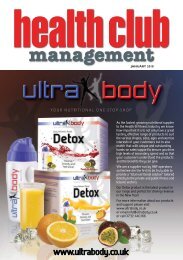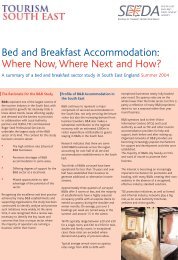Spa Business issue 4 2011 - TourismInsights
Spa Business issue 4 2011 - TourismInsights
Spa Business issue 4 2011 - TourismInsights
You also want an ePaper? Increase the reach of your titles
YUMPU automatically turns print PDFs into web optimized ePapers that Google loves.
<strong>Spa</strong>s report they<br />
use a basic offer to<br />
attract new business<br />
via deal sites, then once<br />
customers call to book,<br />
they upsell them<br />
PHOTO:ISTOCK.COM/©STÍGUR KARLSSON<br />
the deal the more volume will be generated,<br />
so the pressure is often to go for deep discounts,<br />
even if it means it drives the spa into<br />
a loss-making position – the deal site doesn’t<br />
care, because it gets its cut regardless. The<br />
proportion due to the deal site ranges from<br />
15 per cent for those on travel agency rates<br />
anywhere up to 80 per cent.<br />
WHO ‘OWNS’ THE CUSTOMER?<br />
Customer ‘ownership’ is a big <strong>issue</strong> and it<br />
all comes down to who owns the contact<br />
details and to whom the customer feels loyalty<br />
– the deal site or the spa?<br />
There’s anecdotal evidence that customers<br />
can sometimes feel more loyal to the deal site,<br />
with the spa element of the transaction being<br />
a commodity to be bought at the cheapest<br />
rate. This is a contentious point which goes<br />
to the heart of the relationship between the<br />
deal site and the spa operator.<br />
‘Ownership’ revolves around the customer’s<br />
email address, so this is subtly fought<br />
over, with the deal site limiting the information<br />
it passes over to the operator – typically<br />
just the name and booking number – and<br />
the operator looking for the first opportunity<br />
to capture the customer’s email so they<br />
can set up a link to sell deals direct.<br />
Some booking software tackles this by<br />
ensuring customer’s email address and contacts<br />
are captured at checkout under the<br />
credible guise of emailing a receipt. They<br />
can then be stored to the customer record.<br />
Other operators report that they use a basic<br />
offer to attract customers via deal sites – a<br />
well-priced 30-minute massage, for example<br />
– and then once the customer calls to book,<br />
they upsell them to either a longer treatment<br />
or offer add-ons, such as facility use.<br />
So how do you prevent existing customers<br />
being upset by seeing better deals popping<br />
up in deal sites? The advice is to email them<br />
personally the day before thanking them for<br />
their custom and offering them a deal which<br />
is as good or better than the one that’s about<br />
to be pushed out through the deal site.<br />
Although most deal sites would prefer<br />
this didn’t happen, their contracts can’t normally<br />
prevent it, although some will insist<br />
on exclusivity on deals. An alternative is to<br />
build in an extra discount for loyal customers<br />
and deliver this via the deal site.<br />
CREATING GREAT DEALS<br />
The key to structuring a successful deal is<br />
finding a formula which creates a margin for<br />
the spa and deal site while making a compelling<br />
offer for the consumer.<br />
Popular options include two-for-one deals,<br />
which are reportedly more successful than<br />
buy one, get one free – indicating how small<br />
differences can have a big impact. Another<br />
option is to focus on adding value by bundling<br />
in own-brand product lines: mark-ups<br />
on these are usually sufficient to allow a<br />
product to be combined with a treatment<br />
to make a package with high perceived value,<br />
while allowing a good margin for the spa.<br />
This approach only works with own-label<br />
products, however, because retailed brands<br />
have minimum pricing which prevent discounts.<br />
Well-known retail brands add a value<br />
of their own and operators report they can<br />
justify up to 10 per cent higher prices on a like<br />
for like treatment as part of a deal.<br />
The use of deal sites by spas is a sign the<br />
industry’s finally starting to get to grips with<br />
yield management – many years after the<br />
hotel and airline industries. These sectors,<br />
along with other areas of the travel trade,<br />
have educated consumers to expect premium<br />
pricing for peak times, discount for<br />
off-peak and special deals for loyalty.<br />
When deal sites first started making an<br />
impact on the industry, some operators<br />
expressed their horror at what they saw as<br />
the devaluing of their offer and the undermining<br />
of margins. But things have moved<br />
on and our investigations for this feature<br />
reveal that many spa operators are using<br />
them with increasing effectiveness.<br />
Turn the page to read our expert comments<br />
on how spas can exploit the opportunities<br />
presented by deal sites, while safeguarding<br />
their reputation and bottom line.<br />
SPA BUSINESS 4 <strong>2011</strong> © Cybertrek <strong>2011</strong> Read <strong>Spa</strong> <strong>Business</strong> online spabusiness.com / digital 25

















